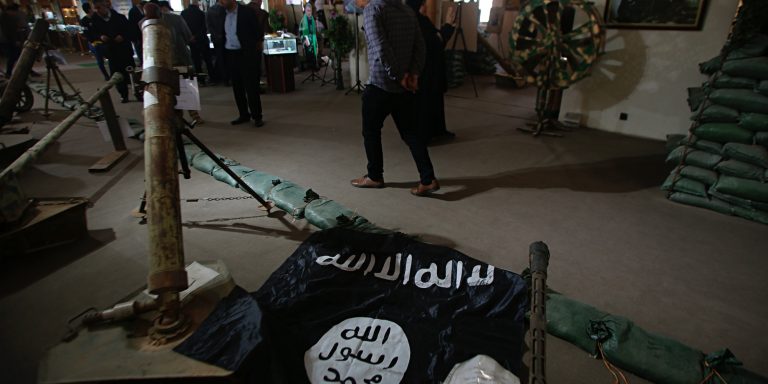INTELBRIEF
February 19, 2019
IntelBrief: The Islamic State Will Live on Through Its Affiliates

- Even after the collapse of the territorial caliphate in Iraq and Syria, the Islamic State will live on through its franchise and affiliate groups.
- Among the most capable affiliates are those in Egypt’s Sinai Peninsula, the Islamic State Khorasan Province in Afghanistan and IS’ branch in Libya.
- The affiliates are geographically dispersed and vary in capability; some are akin to terrorist groups, while others behave like insurgent groups.
- The West is focused on absolute defeat based on experiences fighting nation-states; with the Islamic State, it is about mitigation and containment, not complete military destruction.
President Trump recently announced the end of the so-called Islamic State’s caliphate in Iraq and Syria, tweeting ‘We are pulling back after 100% Caliphate victory.’ And while it is true that the U.S.-led Global Coalition to Defeat ISIS has finally reclaimed all the territory IS once controlled in Syria, the group’s meteoric rise to infamy was never just about territory. Even after the collapse of the territorial caliphate in Iraq and Syria, the Islamic State will live on through its franchise and affiliate groups. IS is a truly global organization and through its media products, the resonance of its message will continue to inspire individuals in from across the globe. Even without territory, IS will be able to raise money and likely has enough of a reserve that small cells of fighters will have adequate resources to rebuild and resurge in Iraq and Syria, completing the transition from state building to guerrilla warfare and low-intensity conflict.
Currently, the Islamic State maintains affiliates and franchise groups from North Africa to South Asia. Just last week, CENTCOM commander General Joseph Votel stated that IS still has ‘tens of thousands’ of fighters in Syria and Iraq. Accurate figures are hard to assess, but reliable estimates suggest that IS boasts hundreds of fighters in various locales (with ranges appearing in parentheses), including Afghanistan (500-1000), Libya (500-800), the Philippines (750), Egypt’s Sinai Peninsula (500-750), West Africa (3500) and Yemen (100-250). IS affiliates flourish in regions plagued by weak governance, porous borders and inept security force. As with al-Qaeda, it is likely that one of IS’ affiliate groups will ultimately evolve to become more dangerous than the core group. Both al-Qaeda in Iraq (which then became IS) and al-Qaeda in the Arabian Peninsula developed into highly capable offshoots of the original terrorist group. Several of IS’ affiliates possess similar potential.
Affiliates are geographically dispersed and vary in capability; some are akin to terrorist groups, while others behave like insurgent groups. Some, like the Islamic State in West Africa Province, have implemented actual governance schemes. Others, like IS in the Sinai, remain capable of launching spectacular attacks against Egypt’s security forces while also targeting civilians with impunity. The affiliates will continue to be buoyed by a consistent stream of IS propaganda. The Islamic State will embrace nostalgia as a multidimensional tool—the ‘nostalgia narrative’ will likely be deployed at a transnational level through its central media units, at the provincial level through its provincial media units and at highly localized and even individual levels through on-the-ground networks.
The West is focused on absolute military defeat, based on experiences fighting nation-states; with the Islamic State, it is about mitigation, not destruction. IS never saw the caliphate in Iraq and Syria as the only representation of its power. The establishment of the caliphate may represent the apex of its achievement, but IS and its adherents have always assumed a long-term view of their quest to establish a permanent state ruled by sharia law. Even without the territorial caliphate, nation-states now must wrestle with what to do next, a challenge that includes how to handle returning foreign fighters and their families. There is no universal approach to dealing with the issue, as some states will adopt more punitive measures, while others may seek to reintegrate returnees by advocating for a softer approach. Perhaps the most important issue will be figuring out how to handle the children of the caliphate, both those left behind in Mosul and Raqqa, but also the Westerners who are now seeking to return to their homelands, where domestic populations are fiercely debating punishment versus rehabilitation and even whether their countries should let them return at all. Creeping sectarianism and longstanding grievances that were never properly addressed will inevitably fuel the Islamic State’s resurgence, potentially dragging the United States back to a conflict Trump just declared to be concluded.
.
For tailored research and analysis, please contact: info@thesoufancenter.org
[video width="960" height="540" mp4="https://thesoufancenter.org/wp-content/uploads/2019/02/IB-0219.mp4" poster="https://thesoufancenter.org/wp-content/uploads/2019/02/Screen-Shot-2019-02-19-at-00.54.19-1-e1550527297957.png"][/video]